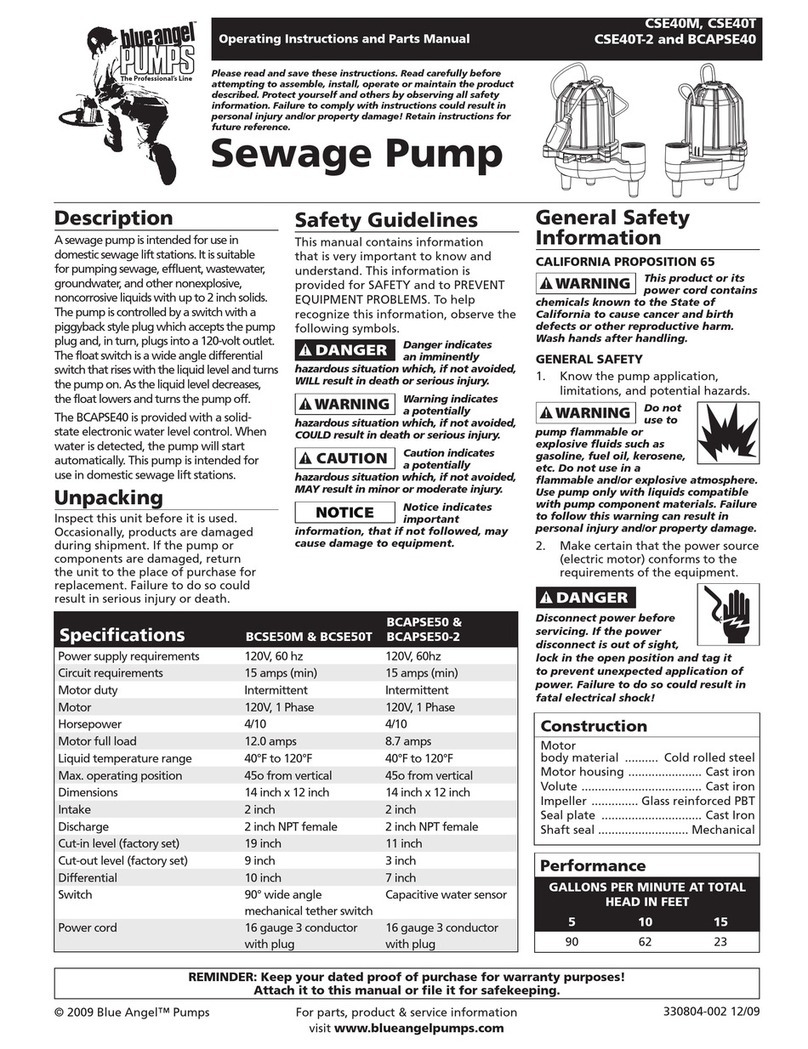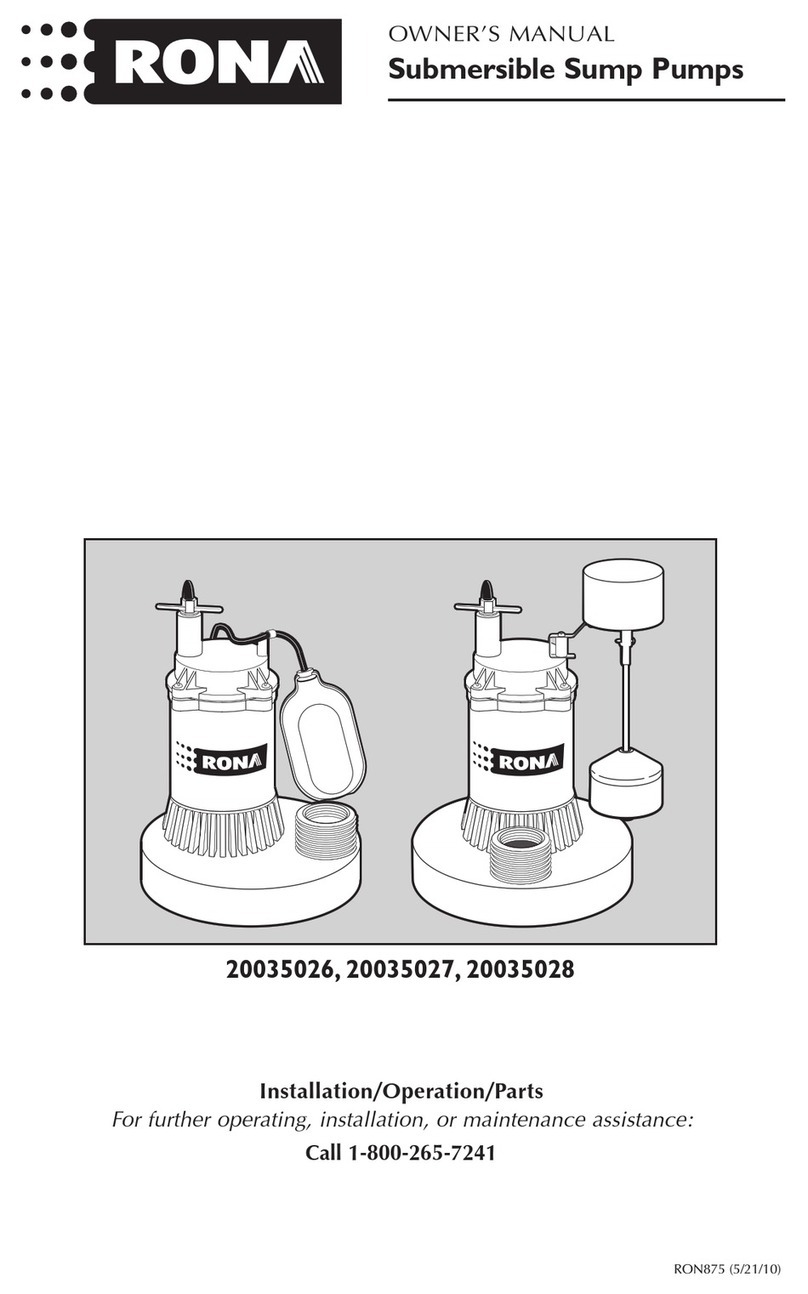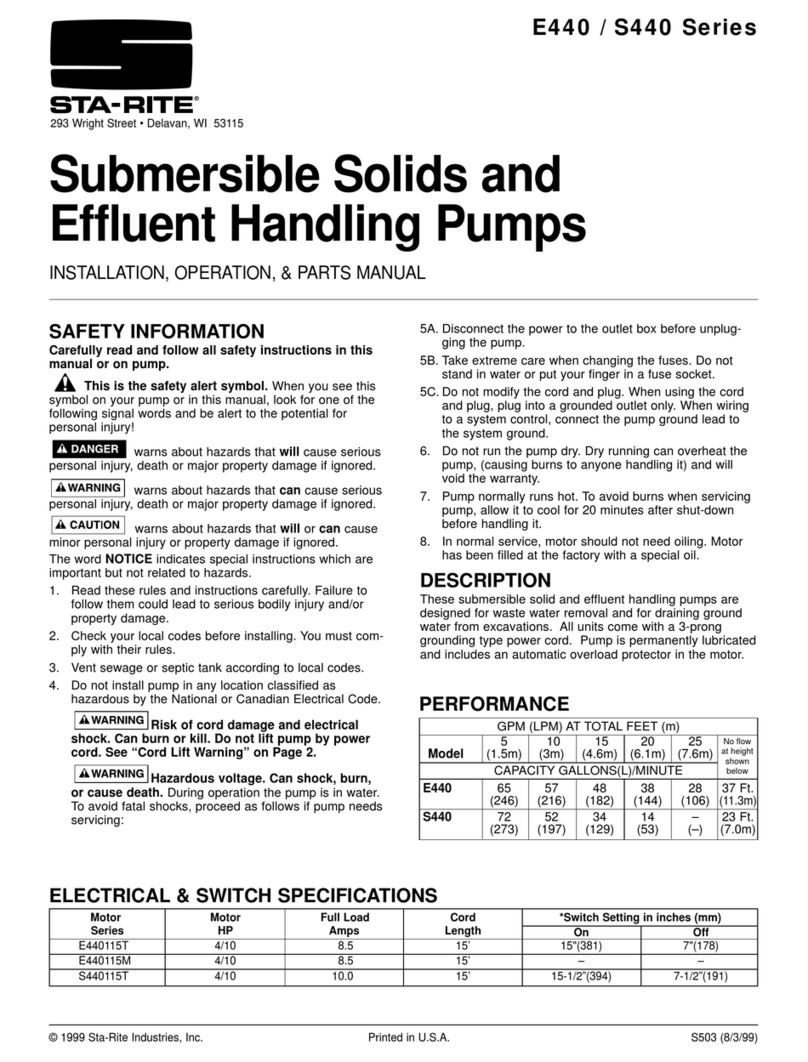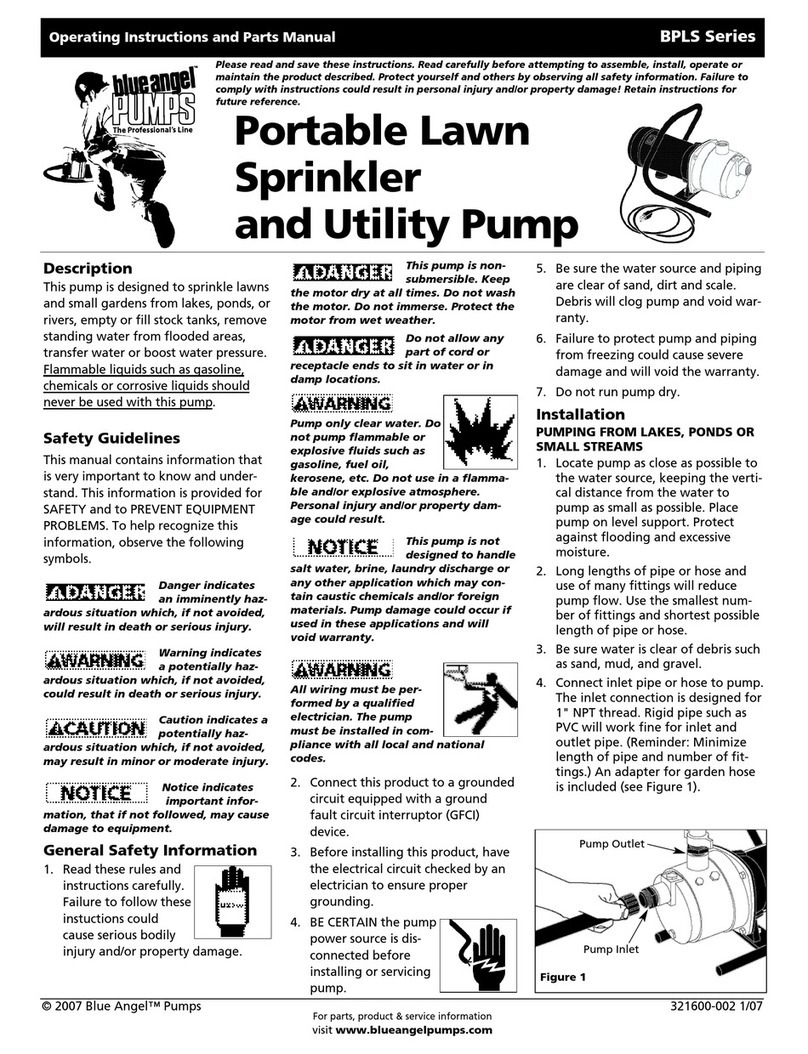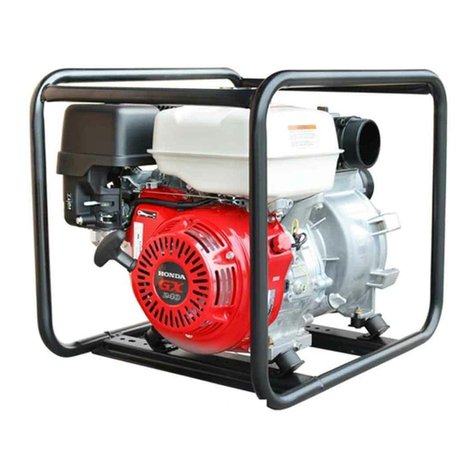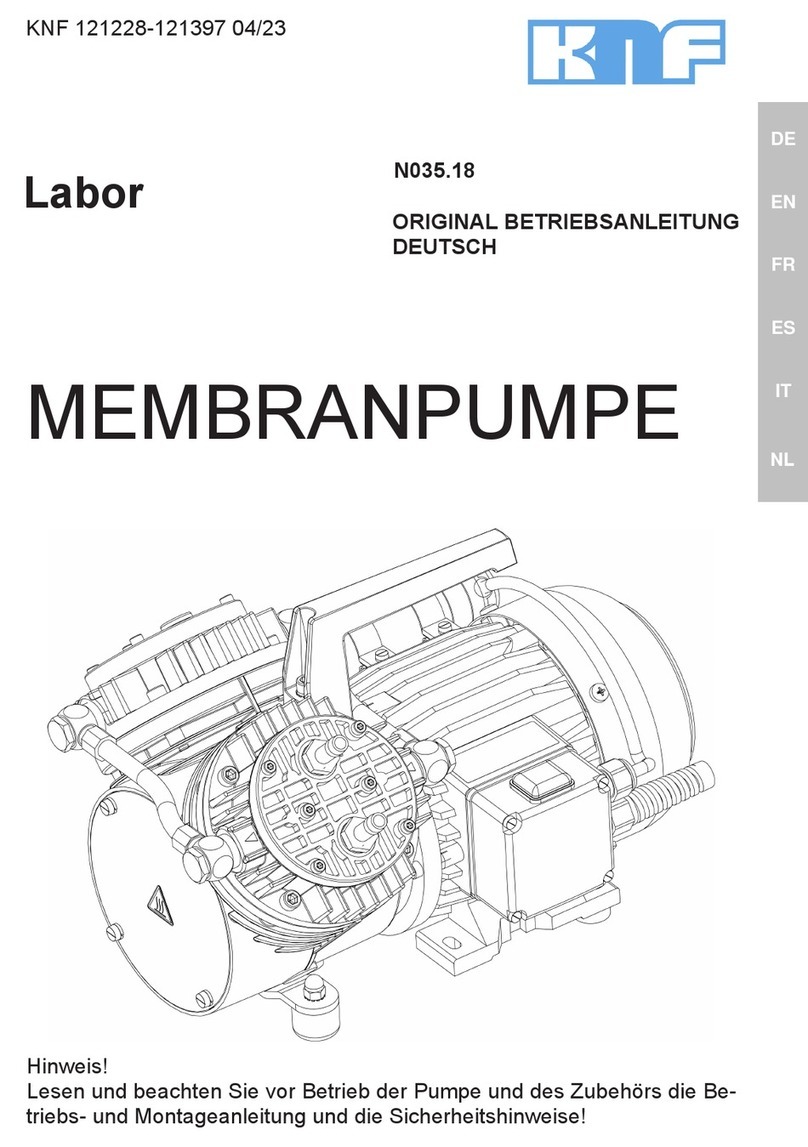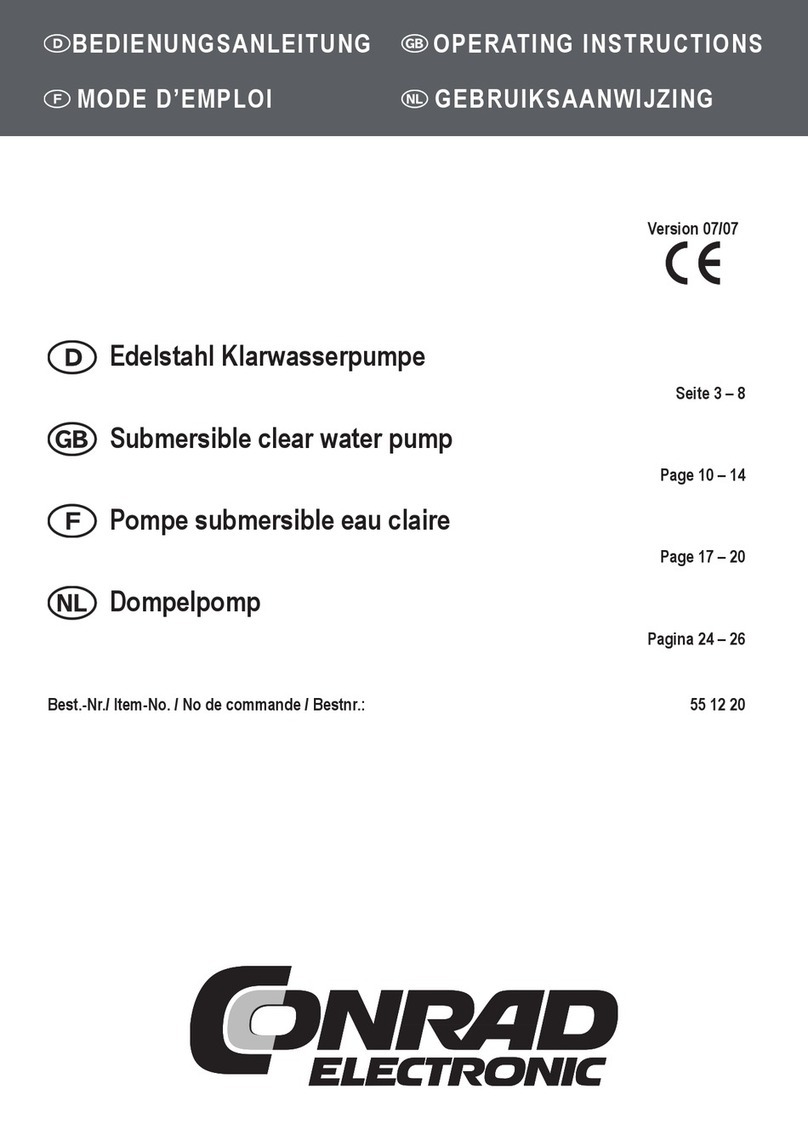Manual de Instrucciones y Lista de Repuestos
Bomba para Regar Césped
18 Sp
agua limpia. Encienda la bomba. Si la
Funcionamiento
(Continuación)
bomba no comienza a bombear agua
en 10 minutos, apáguela y llénela de
agua limpia una vez más.
Si la bomba no funciona después de
varios intentos, chequée lo siguiente:
1. La distancia vertical entre la bomba
y el nivel de agua no debe ser más
de 7,6 metros (25’).
2. Las tuberías de succión deben estar
apretadas herméticamente.
3. Cerciórese de que la(s) válvula(s) de
las tuberías de descarga o de suc-
ción estén abiertas (de haberlas).
Nunca
use la
bomba si las tuberías de descarga están
cerradas u obstruídas. El agua dentro
de la bomba podría hervir y dañar la
bomba.
Mantenimiento
El motor de la bomba debe mantenerse
bien ventilado. Los cojinetes del motor
vienen de fábrica lubricados de por vida.
Éstos no necesitan lubricación adicional.
DURANTE EL INVIERNO
Siempre proteja la bomba y las tuberías
contra temperaturas congelantes. Si
hay peligro de que se congelen, drene
el sistema. Para drenar el sistema:
1. Quítele el tapón al conector en T de
la tubería de descarga.
2. Quítele el tapón de 6,4 mm (1/4”)
ubicado en la parte inferior del
frente de la bomba.
3. Drene todas las tuberías ubicadas
por debajo de la línea de conge-
lamiento.
Capacidad de las Bombas de 3/4 CP en Litros/Hora
Distancia Presión de Trabajo (bar)
en Metros 0,69 1,38 2,07
Capacidad de las Bombas de 1 CP en Litros/Hora
Distancia Presión de Trabajo (bar)
en Metros 0,69 1,38 2,07
Capacidad de las Bombas de 1-1/2 CP en Litros/Hora
Distancia Presión de Trabajo (bar)
en Metros 0,69 1,38 2,07 2,76
Capacidad de las Bombas de 2 CP en Litros/Hora
Distancia Presión de Trabajo (bar)
en Metros 0,69 1,38 2,07 2,76
3,2 cm (1-1/4”) 0,179 0,269 0,379 0,648 0,972
3,8 cm (1-1/2”) 0,083 0,179 0,303 0,462 0,648 1,096
5,1 cm (2”) 0,041 0,055 0,089 0,138 0,193 0,324 0,489 0,689
6,4 cm (2-1/2”) 0,041 0,055 0,083 0,089 0,207 0,289
* Multiplique por 1,8 si usa tubos de acero
Pérdida debido a la fricción por cada 30,5 metros de tubos de plástico bar *
Diám. del (Litres por Hora)
Tubo 4,542 5,678 6,814 9,085 11,356 13,627 18,170 22,712 27,255
1,5 14,761 12,566 8,781
3 14,308 11,810 7,949
4,6 13,627 11,015 4,504
6,1 12,302 10,107 3,747
7,6 11,394 9,690 3,179
1,5 16,693 14,838 9,728
3 15,823 13,324 8,706
4,6 14,498 12,643 6,738
6,1 13,930 11,583 4,391
7,6 12,643 10,296 4,769
1,5 18,132 16,958 13,173 7,797
3 17,450 16,315 12,075 5,753
4,6 16,352 15,293 10,977 0
6,1 14,763 14,081 10,144 0
7,6 14,422 12,491 9,047 0
1,5 22,636 21,046 16,315 11,583
3 20,479 19,759 15,482 10,901
4,6 19,797 18,851 14,763 9,728
6,1 15,595 14,535 13,286 8,365
7,6 15,065 13,627 12,491 0
Operation
Never run the
pump dry. Running
pump without water may cause seal
damage. Fill the pump with water
before starting.
PRIMING THE PUMP
After pump installation is complete,
the pump must be primed. Remove the
pipe plug in the discharge piping and
fill the pump and suction pipe with
clean water. Turn power to pump on. If
the pump does not pump water in 10
minutes, turn off the pump and refill
with clean water.
If the pump does not operate after
repeated attempts, check the follow-
ing:
1. Vertical distance of pump to water
level must not be over 25 feet.
2. Suction piping must be air tight.
3. Be sure valve(s) are open if used in
discharge or suction piping.
Never run the
pump with a
closed or clogged discharge. The water
inside the pump could boil and damage
the pump.
Maintenance
Maintain adequate ventilation for the
pump motor. The motor bearings are
permanently lubricated at the factory.
Additional lubrication is not required.
3
Operating Instructions and Parts Manual
Dug Well, Cistern, Lake And
Spring Installation
1. Install a foot valve on the inlet pipe
and lower into the water.
Locate foot valve
no closer than 2
feet from the bottom of the water
source so sand or sediment is not
drawn into the system.
NOTE: When a lake is used for the
water supply, make sure the suction
pipe is deep enough to be submerged
at all times. Slope the pipe upward
toward the pump to eliminate trap-
ping air. The pipe must be removed
during winter months or protected
against freezing.
Protect the pipe
from damage by
swimmers and boaters.
Electrical Connections
Connect the pump to a separate elec-
trical circuit with a dedicated circuit
breaker. Refer to the electrical specifi-
cations in wiring chart for recommend-
ed circuit breaker and wire size.
Install and maintain wiring for this
pump in accordance with the National
Electrical code and all applicable local
electrical codes.
The motor must be grounded by con-
necting a copper conductor to the
















